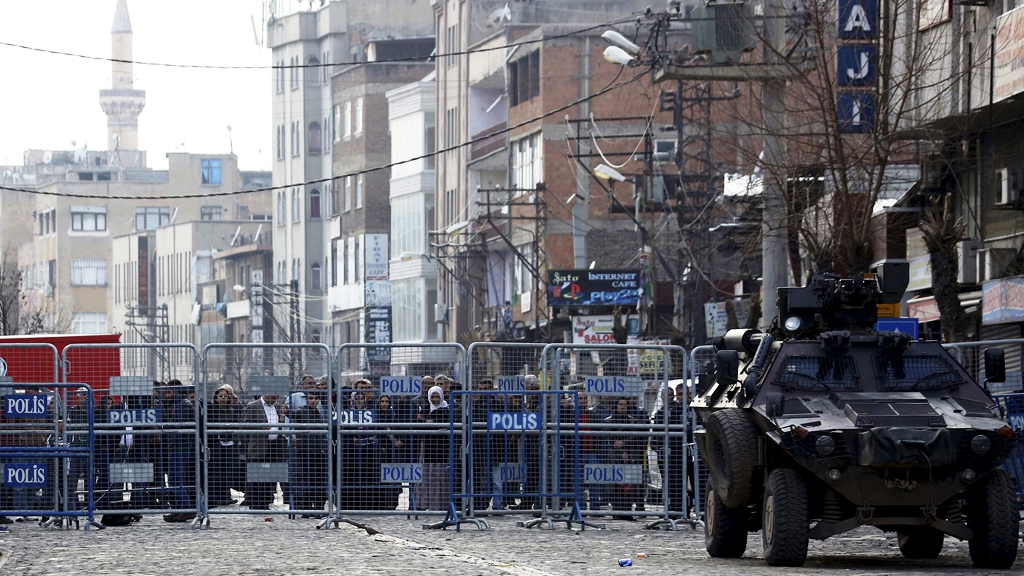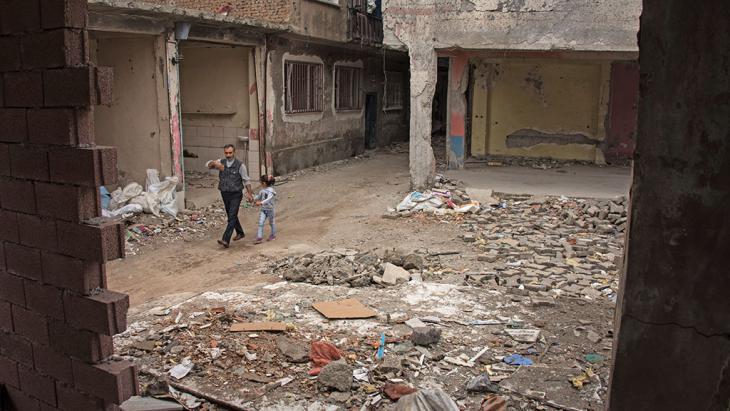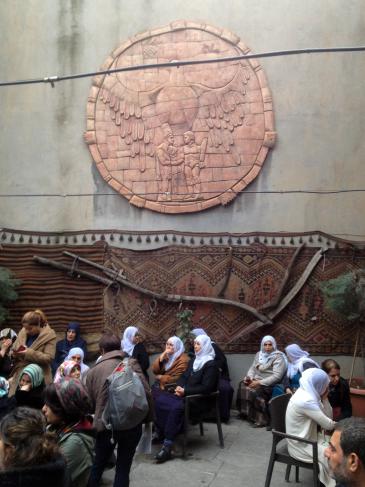The spoils of urban warfare

Take a stroll through the Gazi Caddesi in Diyarbakir's ancient neighbourhood of Sur and you'll be astonished at how busy it is on the main street. But appearances are deceptive: "Most are only here to have a look at the damage," complains one trader. Indeed, many people feel drawn to Sur by a mixture of fear and yearning: "I have only just plucked up the courage to come and look at the streets of my childhood. But without the Old Town, Diyarbakir is a place without a soul," says one passerby.
So what has happened to Diyarbakir's soul? Following the failure of a two-year ceasefire, the Turkish army launched a 104-day military operation against the PKK youth organisation YPS in the Kurdish city. The fighting, which saw heavy weapons used in residential areas and curfews imposed for months, forced 24,000 people to flee Sur.
Even though the fighting has now ended, there's a heavily armed police presence on the streets. Concrete blocks close up the gaps in the historic city walls, recently included on the UNESCO list of world cultural heritage sites. The numerous police checkpoints are also contributing to the tense atmosphere. It is evident from the planned construction of 12 new police stations and four watchtowers in the Old Town that this is not a temporary nuisance, but a permanent deterrent and demonstration of military superiority.
The alleyway where the human rights lawyer Tahir Elci was murdered in November 2015 – a man who had warned of the cultural destruction of the Old Town just minutes before his death – is sealed off with a white tarpaulin. When the wind blows in a certain direction, it's possible to see the ruins behind it. On the edge of the former battle zone – still cordoned off – which was invaded by convoys of demolition trucks no sooner the fighting stopped, families are still waiting to gain access to their houses, or what is left of them.

Mass destruction
It is thought that some 80 percent of the buildings in this area were badly damaged, including listed buildings such as the historic Kursunlu Mosque or the Armenian-Protestant church. It is known that the army tore down entire alleyways to enable the advance of their heavy vehicles. It is feared that historic structural elements will also be damaged in the hasty "clean-up operation". Aerial views show gaping holes in what used to be densely populated residential blocks.
Sur – up until just a few months ago, a lively microcosm with labyrinthine alleyways, gossiping neighbours and a vibrant bazaar. A place full of personal and collective memories, where Armenian, Chaldean and Assyrian churches, the Byzantine city wall, Ottoman mosques and caravanserais testified to a – if sometimes troubled – multicultural past.
Most Armenians, Assyrians and Yazidis had long left Sur when in the 1990s, thousands of Kurds fled the conflict between the PKK and the army, entering the city from surrounding villages. They set up new homes overnight that were not as beautiful as their historic predecessors and the new arrivals also inflicted some damage on the structures of the houses they were occupying. But thanks to its residents, the Old Town was still a very vivacious and appealing neighbourhood from a social perspective.
One of the most miraculous developments of recent years was the meticulous reconstruction of historic buildings by the city authorities dominated by the pro-Kurdish BDP and private initiatives. A high point was the consecration of the Armenian Surp Giragos Church that, after years of neglect, was restored in 2011 with the help of private funds. It is now open to the community again and in use as a house of worship.

The opening of the Dengbej House, where Kurdish writers would present their work, as well as numerous studios and small cafes serving Armenian cuisine and playing Kurdish music, marked a new wave of civil engagement, reviving the cultural legacy of the city. By contrast – to counter the rather more rampant growth in Sur – the state authorities launched new residential housing development projects in 2011, emulating the military style that has transformed Turkish cities into anonymous concrete tower block estates since 2002.
Old Town under public ownership
Halfway through, in 2013, the initiative was derailed by public resistance, whereby several parts of the Old Town were swiftly declared to be "risk areas" in danger of collapse – a step that is now facilitating state access.
Following the ceasefire declaration, urgent calls for a collective inspection of the battle zone by the city administration but also by various civil groups, fell on deaf ears. On 21 March, the day of the Kurdish New Year festival, the Turkish government instead voted to nationalise the Old Town: 6,600 out of a total of 7,300 plots in the Old Town are to pass into public ownership. Its rapid reconstruction is to proceed simultaneously.

This fast push confirms what many view as a reason for Ankara's aggressive military policy in Diyarbakir and other south-eastern towns and cities: the enforced demographic and structural transformation of these strongly politicised, Kurdish dominated locations into profitable areas that are above all easier to control. The bar association in Diyarbakir has already filed a lawsuit. The reason: a massive violation of property ownership rights.
"What we're dealing with here is a decision taken unilaterally from above," says Serefhan Aydın from the Diyarbakir architectural association that, like the city administration, but also many civil organisations, is not involved in the newly formed development commission. "We are very worried that the urban development and social plans envisaged for Sur will not serve to invigorate the city, but rather to establish a military security structure."
The demolition of entire neighbourhoods is turning temporary flight into permanent resettlement: for many families from Sur, this would be the second time in their lives that they have been expelled. The sociologist Adnan Celik goes a step further: "The state's blockade policy, which is itself based on spatial destruction and depopulation, was not aimed solely at death, expulsion and the loss of material property. At the same time, Sur is being largely destroyed as a place of remembrance with numerous bearers of a millennia-old heritage. This disinheritance is, in the form of mnemocide, as well as depopulation, the actual goal of these operations."
″Nationalisation is part of the war″
"We are the spoils of war," says Sedat from the Cafe Suluklu Han, laconically. "The nationalisation is part of the war." The cafe in the heart of the Old Town had in recent years become a stage for musicians, writers and intellectuals. Today, it serves as a gathering point for furious shop owners who see their livelihoods severely threatened by the latest developments.
Among those present is Roj, the manager of the cafe in the Armenian Surp Giragos Church. He is still hopeful that its status as foundation property will protect the church – but who can be sure of that, in this atmosphere of increasing lawlessness in Turkey. First and foremost he has to get inside the church again, something he's not been able to do for months.
Meanwhile the government has released a short commercial on the reconstruction of Sur, a concoction that whitewashes the past, showing virtual citizens promenading through a sanitized Old Town between magnificent Ottoman and Seljukian buildings. "The soundtrack is the call of the muezzin, the buildings look like tacky figurines and of course there's a huge Turkish flag fluttering over the city walls. This badly made film is a far cry from the 7,000-year-old soul of Sur," writes the journalist Nurhan Baycal in an acerbic comment piece.
This would not be the first time in Turkish history that destruction has been followed by expulsion and resettlement. In view of the events in Diyarbakir and Cizre, but also ongoing operations in Nusaybin, Sirnak and Yuksekova, there are fears that it might also not be the last.
Sonja Galler
© Qantara.de 2016
Translated by Nina Coon